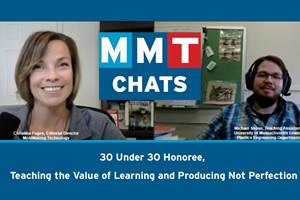Procter and Gamble's Corporate Donation Propels RP Research into the New Millennium at the Milwaukee School of Engineering
Procter & Gamble donated more than 40 U.S. and international patents to the Milwaukee School of Engineering.
Late last year, Procter & Gamble made one of its largest corporate donations ever - more than 40 U.S. and international patents with accompanying intellectual property - to the Milwaukee School of Engineering (MSOE), pioneers in rapid prototyping research and system applications.
The patents comprise Procter & Gamble's proprietary PHAST (Prototype Hard and Soft Tooling) technology, which drastically reduces the time it takes to design molded parts in a wide variety of industries, pushing products into the marketplace faster. According to P&G Chief Technology Officer Gordon Brunner, "A world-class technology like PHAST needs a world-class leader in rapid prototyping to develop it. MSOE is that leader."
MSOE Dean of Applied Research Tom Bray says that Procter & Gamble selected the university unbeknownst to them. "They hired a consultant - an expert in the rapid prototyping field not connected to any one business or technology - to do a survey of the entire U.S. university population," he explains. "The consultant then selected a number of schools, and from that group, he picked two or three that were the top schools, and we were among them - because of our ability to use, develop and market this PHAST technology. While we knew nothing of this technology, what we have been doing for several years is developing moldmaking technology on our own for casting, injection molding, etc."
Procter & Gamble then made site visits to the top few schools before selecting MSOE. "I believe one of the major reasons we're successful is that we have involved a tremendous number of students in this that are supported by an extraordinary staff," Bray states. "We bring students in from around the country under sponsorships by the National Science Foundation. It's called the Research Experience for Under-graduates program, and they come in and do research in tooling, architecture, bio-molecular modeling and medical modeling. We are continually fabricating real-world objects and molds."
The possibilities with the PHAST technology are endless, Bray feels, and will help further research and development at the school's Rapid Prototyping Center (RPC) and the Rapid Prototyping Consortium, both established in 1991. "We are in the process of transferring the technology from P&G to the RPC," Bray comments. "What we know about PHAST right now is that it will be for prototype quantities - it is still unknown if it can be used in production quantities. Our first step is to reproduce the process on campus - there's no way we can license it out unless we know how the process works and what its qualities and characteristics are. We will make real molds and real parts for real clients."
According to Bray, MSOE is the only university in the country to utilize the four major prototyping systems at the RPC - stereolithography (SLA), laminated object manufacturing (LOM), selective laser sintering (SLS) and fused deposition modeling (FDM). "We're taking all forms of these materials - liquids, powders and solids - and merging them," Bray comments. "We are generating a tremendous amount of intellectual property - all kinds of geometries and material combinations, and some of these are going to be patented.
"People who walk into the Center are blown away - I don't care if they are five years old or 85 years old, whether they are an engineer or a nurse, they see models of all kinds of things," Bray continues. "We're doing a tremendous amount of development - applied toward moldmaking, toolmaking and model making."
The partnership between Procter & Gamble and MSOE promises to be an exciting one, full of surprises and challenges as MSOE strives to make the most of PHAST technology. Bray says that a number of companies worldwide have already contacted him regarding the new technology. "We didn't envision all of this when we started - we're just reacting to all of the possibilities out there," he states. "This is where moldmaking is headed - we are moving into some uncharted territory - and the sooner the industry knows it, the better."
Related Content
Making Quick and Easy Kaizen Work for Your Shop
Within each person is unlimited creative potential to improve shop operations.
Read MorePredictive Manufacturing Moves Mold Builder into Advanced Medical Component Manufacturing
From a hot rod hobby, medical molds and shop performance to technology extremes, key relationships and a growth strategy, it’s obvious details matter at Eden Tool.
Read MoreICYMI, MMT Chats: 30 Under 30 Honoree, Plastics Engineering TA Teaches Value of Learning and Producing Not Perfection
MoldMaking Technology Editorial Director Christina Fuges brings on UMass Lowell Plastics Engineering Teaching Assistant Michael Shone as a guest for this MMT Chat to discuss moldmaking through the lens of academia. This episode is brought to you by ISCAR with New Ideas for Machining Intelligently.
Read MoreExploring ISO 9000 - Part 16 Control of Quality Records
A Series of International Standards for Quality Management and Quality Assurance. We begin 2022 with a review of Clause 4.16 Control of Quality Records.
Read MoreRead Next
Reasons to Use Fiber Lasers for Mold Cleaning
Fiber lasers offer a simplicity, speed, control and portability, minimizing mold cleaning risks.
Read MoreAre You a Moldmaker Considering 3D Printing? Consider the 3D Printing Workshop at NPE2024
Presentations will cover 3D printing for mold tooling, material innovation, product development, bridge production and full-scale, high-volume additive manufacturing.
Read MoreHow to Use Continuing Education to Remain Competitive in Moldmaking
Continued training helps moldmakers make tooling decisions and properly use the latest cutting tool to efficiently machine high-quality molds.
Read More



.jpg;maxWidth=300;quality=90)


.png;maxWidth=300;quality=90)



_300x250 3.png;maxWidth=300;quality=90)










